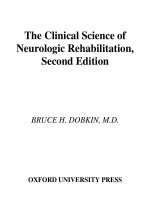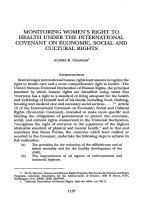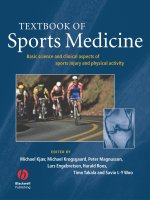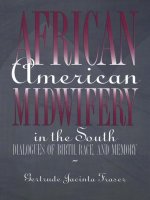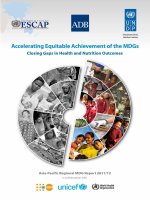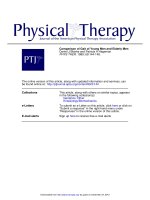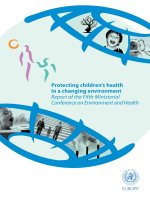The Clinical Practice of Complementary, Alternative, and Western Medicine pot
Bạn đang xem bản rút gọn của tài liệu. Xem và tải ngay bản đầy đủ của tài liệu tại đây (12.32 MB, 377 trang )
The Clinical Practice of
Complementary,
Alternative, and
Western Medicin
e
The Clinical Practice of
Complementary,
Alternative, and
Western Medicin
e
W. John Diamond, M.D.
Boca Raton London New York Washington, D.C.
CRC Press
This book contains information obtained from authentic and highly regarded sources. Reprinted material is quoted with
permission, and sources are indicated. A wide variety of references are listed. Reasonable efforts have been made to publish
reliable data and information, but the author and the publisher cannot assume responsibility for the validity of all materials
or for the consequences of their use.
Neither this book nor any part may be reproduced or transmitted in any form or by any means, electronic or mechanical,
including photocopying, microfilming, and recording, or by any information storage or retrieval system, without prior
permission in writing from the publisher.
The consent of CRC Press LLC does not extend to copying for general distribution, for promotion, for creating new works,
or for resale. Specific permission must be obtained in writing from CRC Press LLC for such copying.
Direct all inquiries to CRC Press LLC, 2000 N.W. Corporate Blvd., Boca Raton, Florida 33431.
Trademark Notice:
Product or corporate names may be trademarks or registered trademarks, and are used only for
identification and explanation, without intent to infringe.
© 2001 by CRC Press LLC
No claim to original U.S. Government works
International Standard Book Number 0-8493-1399-6
Library of Congress Card Number 00-010343
Printed in the United States of America 1 2 3 4 5 6 7 8 9 0
Printed on acid-free paper
Library of Congress Cataloging-in-Publication Data
Diamond, W. John, 1948
The clinical practice of complementary, alternative, and Western medicine / W. John Diamond
p. cm.
Includes bibliographical references and index.
ISBN 0-8493-1399-6 (alk. paper)
1. Alternative medicine. 2. Internal medicine. I. Title.
R733 .D47 2000
615.5—dc21 00-010343
CIP
1399frameFM Page 4 Wednesday, August 23, 2000 10:42 PM
Dedication
To South Africa, the country that nurtured and educated me, and to the United States of America,
the country that gave me the opportunity to do this work. To my loyal patients who held the keys
to the knowledge and allowed me to open the door.
1399frameFM Page 5 Wednesday, August 23, 2000 10:42 PM
1399frameFM Page 6 Wednesday, August 23, 2000 10:42 PM
Author
William John Diamond
was born in Johannesburg, Republic of South Africa on March 28, 1948.
He was educated at Parktown Boys’ High School where he injured his back in a diving accident,
an event that changed his future plans to be a mining engineer. He served his military training at
the Army Gymnasium in Pretoria, was a member of the State President’s Guard, and received a
B.Sc. (anatomy and embryology) in 1970, B.Sc. (Hons) (physiological chemistry) and M.B., B.Ch.
in 1973 from the University of the Witwatersrand Medical School, in Johannesburg, Republic of
South Africa. His internship was served in medicine, and obstetrics and gynecology at the Edendale
Hospital, Pietermaritzburg, Republic of South Africa, and his residency in clinical pathology
(clinical hematology and clinical chemistry) was at the Groote Schuur Hospital of the University
of Cape Town Medical School in 1975 and 1976.
In July 1976, he emigrated with his family to the United States and became a resident in
anatomical pathology in the Department of Pathology and Cytopathology at the Montefiore Hospital
and Medical Center of the Albert Einstein College of Medicine in the Bronx, New York. He was
a clinical fellow at the Clinical Center of the National Institutes of Health in Bethesda, Maryland
in 1978–1979 and later became Scientific Director of the American Red Cross Blood Services,
Syracuse, New York, and was an associate professor of clinical pathology at the State of New York
Health Sciences Center, Upstate Medical Center, Syracuse, New York.
In 1980 he moved to Reno, Nevada and became an attending pathologist with Laboratory
Medicine Consultants, a large pathology group serving Northern Nevada and Western California.
In 1988 he left pathology and opened the Triad Medical Center to offer “Alternative Medicine” to
the citizens of Northern Nevada having received his training in acupuncture at the UCLA Medical
Acupuncture for Physicians course. In 1990–92 he received his homeopathic training at the Pacific
Academy of Homeopathy in Berkeley, California. Master Chinese herbalist Anastacia White was
his teacher in Traditional Chinese Medicine and herbology from 1992 to 1998. Dr. Diamond was
medical editor of
Biological Therapy
, and Medical Director of BHI and Heel, USA in Albuquerque,
New Mexico and of the Botanical Laboratories in Ferndale, Washington during the years
1992–1996. He was the lead author of
Alternative Medicine, a Definitive Guide to Cancer
, published
in 1997.
At the moment he conducts a busy Integrated Medicine practice and is medical director of
Integrated Medicines, LLC, a company dedicated to research and development of innovative
medications based on natural and energetic principles.
1399frameFM Page 7 Wednesday, August 23, 2000 10:42 PM
1399frameFM Page 8 Wednesday, August 23, 2000 10:42 PM
Acknowledgments
There are many people to thank for their interest, help, and encouragement. I wish to thank the
following people who did more than they had to, and were key to formulating my thinking and
outlook on life and medicine: Elliot Wolfe, my English and Latin teacher, for standing by me when
things looked grim; Professor Phillip Tobias, for teaching me the scientific method; Dr. John Cosnett
for teaching me clinical medicine and to appreciate the human body; Professor Leopold Koss for
teaching me pathology and being my first mentor; Dr. Bob Milne and Dr. Yiwen Y.Tang for teaching
me energetic medicine; Dr. David Tansley for opening my mind to the possibilities of esoteric
medicine; and Professor William A. Tiller for showing me that it was real; Dr. Joseph Helms, for
teaching me acupuncture; and Joe Daley and Lynn Amara, for teaching me homeopathy.
I am deeply indebted to Anastacia White, Master Herbalist, for her years of insightful tuition
and guidance, without whom the reflections of TCM and herbal prescribing found in Chapter 6
would not have been possible. The bulk of the herbal patterns discussed there are taken from her
detailed lectures, which I encourage all serious students to attend.
I need to offer great thanks and kudos to Dr. Gary Holt, my very supportive partner, who was
the first doctor to experience if the system could be taught. He must be a good learner, because he
is great at it! Thanks also to his assistants Joanne and Darlena.
I could not have written this book without the help and encouragement of two wonderful friends:
Ron Kendall, who rescued my crashed computer disk multiple times and supplied me with jokes
on e-mail to keep me going, and my dear late friend Stephen Poe, who dared and challenged me
to write this book and egged me on even when he was not feeling well.
I want to thank my clinic staff, receptionists Judy and Cathy and my extremely efficient, loyal,
and long-suffering medical assistant Patty, who have come along for the whole journey. Without
them it would not have been possible, and the patient healing would not have been as complete.
To Vauna, thanks for teaching me about allergy.
Mothers hold the world together, and I wish to thank mine for always seeing the best in me
and allowing me to be an inquisitive child.
Children are the future of the world, and I wish to thank David, Jane, and Rory, my wonderful
children, for teaching me what it was all about. I apologize for always having a book in my hand
and a faraway look in my eye. To my beloved wife, Barbara, who never faltered one step of the
way, but has been heard to say, “There must be a special place in heaven for wives of homeopaths.”
To Barbara Norwitz, Publisher, and CRC Press for having the courage, patience, and foresight
to publish this book.
Last, but not least, to the State of Nevada, Board of Medical Examiners, thank you for being
open-minded and nonjudgmental.
1399frameFM Page 9 Wednesday, August 23, 2000 10:42 PM
1399frameFM Page 10 Wednesday, August 23, 2000 10:42 PM
The Modalities and Assessment
of the Patient
“There are two types of physicians — those that are free men and those that are slaves. The slaves,
to speak generally, are treated by slaves, who pay them a hurried visit, or receive them in
dispensaries. A physician of this kind never gives a servant any account of his complaint, nor asks
him for any; he gives him some imperial injunction with an air of finished knowledge, in the brusque
fashion of a dictator, and then is off in haste to the next ailing servant …. The free practitioner
attends free men, treats their diseases by going into things thoroughly in a scientific way; and takes
the patient and his family into his confidence. Thus he learns something from the sufferers, and at
the same time instructs the invalid to the best of his powers. He does not give his prescriptions
until he has won the patient’s support …. Now which of the two methods is that of the better
physician or director of the bodily regimen?”
Plato, 2500 years ago.
1399frameFM Page 11 Wednesday, August 23, 2000 10:42 PM
1399frameFM Page 12 Wednesday, August 23, 2000 10:42 PM
Contents
Section I: Integrated Medicine — Background
Chapter 1
Introduction 3
A New Paradigm 3
Personal History 3
Chapter 2
Principles of Integrated Medicine 5
Definition of Integrated Medicine 5
Background Concepts 5
Holism 6
The Energetic Component of Medicine 8
Historical and Biological Concepts of Integrated Medicine 9
Who Practices or Uses Integrated Medicine? 10
Patient Issues 13
Practitioner Issues 14
Regulatory Issues 14
Chapter 3
A Brief History of Medical Thought and Politics 17
Chapter 4
Integrated Medical Biology 21
Introduction 21
Thermodynamics in Biology 21
The Current Medical Biological Model 24
The Concept of an Energetic and Functional Biological Model 28
Chaos Theory, Nonlinear Dynamics, and Fractals 28
Components of Disease 31
Disease as a Chronological Continuum 33
Disease as a Meaningful Entity 42
Section II: Traditional Chinese Medicine (TCM)
Chapter 5
Patterns of Diagnosis in Traditional Chinese Medicine 49
Introduction 49
Diagnosis In Traditional Chinese medicine 50
The Language of Chinese Medicine 50
Identification Of Patterns Of Dysharmony 51
The Eight Diagnostic Principles 51
1399frameFM Page 13 Wednesday, August 23, 2000 10:42 PM
The Five Fundamental Substances 55
Qi 55
Blood — Xue 59
Body Fluids — Jin-Ye 60
Essence — Jing 62
Spirit — Shen 63
The Pathogenic Factors or Six Evils 64
Wind 64
Cold 64
Summer-Heat 65
The Seven Internal Emotions as Disease Etiology 65
Fear — Kidneys 66
Anger — Liver 66
Joy — Heart 66
Sadness — Lung 66
Worry/Pensiveness — Spleen 66
Other Causes of Disease 67
Weak Constitution 67
Overexertion 67
Excessive Sexual Activity 67
Diet 68
Trauma 68
Zang-Fu Organ Pattern Identification 69
Lungs (LU) 69
Large Intestine (LI) 71
Spleen (SP) 72
Stomach (ST) 73
Heart (HT) 75
Small Intestine (SI) 78
Kidney (KI) 79
Bladder (BL) 82
Liver (LR) 83
Gall Bladder (GB) 87
Other Patterns of Diagnosis in TCM 88
Patterns According to the Six Stages 88
Patterns According to the Four Levels 88
Clinical Use of Six Stages and Four Levels 89
Chapter 6
Chinese Herbal Prescribing 91
Inlassification of Chinese Herbs 92
Energy and Effects 92
Element, Taste, and Color 92
Actions 92
Therapeutic Categories 93
The Eight Methods of Herbal Therapy 98
Herbal Action 101
Qualities of Herbs 101
Parts of the Herb 102
Theory of Herbal Combining 102
Herbs — Clinical Discussion 103
1399frameFM Page 14 Wednesday, August 23, 2000 10:42 PM
Chapter 7
Acupuncture 105
Introduction 105
Embryological and Energetic Anatomy 106
The Curious or Extraordinary Merdians 107
Tendinomuscular Meridians (TMM) 117
Principal Meridians 119
The Concept of Triple Heater (TH) 121
Tai Yang Subcircuit 122
Shao Yin Subcircuit 129
The Shao Yang Energy Subcircuit 135
The Jue Yin Energy Subcircuit 141
The Yang Ming Energy Subcircuit 147
The Tai Yin Energy Subcircuit 155
Extra Acupuncture Points (EX) 160
Ah Shi Points 162
Mu Subsystem of Points 162
The Distinct Meridian Subsystem 165
Special Point Groupings 167
Luo-Yuan Shunts 167
Accessory and Group Luo Points 168
Tsri or Xi–Cleft Points 168
Hui, Roe, or Influential Points 169
The Cerebral Circulation Subsystem 169
Upper and Lower He Points 170
Windows of the Sky Points 170
Special Command Points 171
Points of the Four Seas 171
The Horary, Phase, or Natural Point 171
The Five Classical Shu or Command Points 172
Activation of the Principal Meridians173
The N
→
N+1 Therapeutic Input Program 173
The Five Elements or Phases Paradigm 174
The Sheng Cycle 175
Ko Cycle 176
The Mother–Son Law 177
The Clinical Practice of Acupuncture 178
The Needle 178
The Patient 180
Complications from Acupuncture 181
Patient Results 181
Selection of Acupuncture Programs 182
Pain Problems 182
Organ Dysfunctions 182
Ventral, Lateral, and Dorsal Treatment Programs 182
Auricular Acupuncture 183
Embryology, Anatomy, and Neurophysiology of the Auricle 183
Lesional and Master Points 183
Clinical Use of Auriculotherapy 186
Indwelling Tacks, Seeds, Magnets, and Lasers 187
Substance Abuse Management 187
1399frameFM Page 15 Wednesday, August 23, 2000 10:42 PM
Korean Hand Acupuncture (KHA) 188
Advantages of KHA 190
Clinical Applications of KHA 190
Yamamoto New Scalp Acupuncture 190
YNSA Acupuncture Points 191
YNSA Basic Points (A–I) 191
YNSA Sensory Points (1-4) 193
YNSA Brain Points 193
YNSA Ypsilon Points 193
YNSA Abdominal Diagnostic Zones 193
YNSA Neck Diagnostic Zone 194
YNSA Clinical Practice 194
Neuroanatomical Acupuncture 194
Percutaneous Nerve Stimulation (PENS) 194
Periosteal Acupuncture Stimulation 197
Other Reflex Acupuncture Systems 198
Other Energetic Acupuncture Systems 198
Electroacupuncture 198
The Physiology of Needle Insertion 199
Electric Parameters of Acupoints 199
Basic Electricity 200
Body Electricity 201
Cell Membrane Electronics 201
The Electronics of Cell Injury 201
Electronic Healing 202
Electrotherapeutic Techniques 202
Physiological Responses to Electrical Stimulation 202
Electrical Frequencies Used in Treatment 203
Milli- vs. Microamperage Acupuncture 203
Celluar Effects of Microcurrents 204
Techniques and Applications of Electroacupuncture 204
Electrical Auriculotherapy 205
Clinical Uses 205
General Guidelines for Using Electroacupuncture 206
Acupuncture Circuits for Electrostimulation 207
Other Methods of Tonification 208
Moxibustion 209
Radiant Heat Lamp 209
Section III: Other Forms of Alternative Medical Treatment
Chapter 8
Homeopathy 213
History 213
Homeopathic Concepts 213
The Law of Similars 213
The Law of the Minimum Dose 213
The Totality of Symptoms 214
The Law of the Single Remedy 214
The Law of Cure 214
1399frameFM Page 16 Wednesday, August 23, 2000 10:42 PM
Homeopathic Provings and Therapy 215
Materia Medica and Repertory 216
Homeopathic Schools of Practice 217
Classical Homeopathy 217
Complex Homeopathy 218
French Pleuralistic and Constitutional Therapy 218
Homotoxicology by H. H. Reckeweg 219
Electronic Homeopathy 222
The Homeopathic Pharmacy 223
Preparation of a Homeopathic Medicine 223
The Science of Homeopathy 223
The Practice of Homeopathy 224
Posology — Homeopathic Dosing 224
Chapter 9
Anthroposophical Medicine 227
Chapter 10
Neural Therapy 229
History of Neural Therapy 229
Neural Therapy Theory 229
Interference Fields 229
The Nervous System Theory 230
The Fascial Continuity Theory 231
The Matrix–Ground System Theory 231
The Lymphatic System Theory 231
The Tooth–Fuse Box Theory 231
The Clinical Practice of Neural Therapy 233
Chapter 11
Bioenergetic Medicine 235
Bioenergetic Measurements 235
The Electrical Approach 235
The Indirect Approach 241
The Clinical Applications of Biokinesiology 242
Bi Digittal O-Ring vs. Straight Arm Muscle Testing 242
The Practitioner 242
Bi-Digital O-Ring Muscle Testing 243
Disorder Control 243
Polarity Check — Switching 243
Hand Electrode and Testing Block 243
Testing Energetics 244
Energetic Pattern Modification 249
Allergy Desensitization by Autonomic Nervous System Repatterning
(ALR-G-ANSR) 250
Chapter 12
Ayurvedic Medicine 257
History and Concepts 257
The Five Fundamental Elements 257
1399frameFM Page 17 Wednesday, August 23, 2000 10:42 PM
The Three Energy Types 257
Etiology and Diagnosis of Disease 258
Pathophysiology of Disease 259
Treatment Options 259
Clinical Use 260
Chapter 13
Western Herbology or Phytotherapy 261
History and Background261
Terms Used in Phytotherapy 261
Pharmacology of Western Herbs 261
Herbal Preparations 263
Therapeutic Actions of Herbs 264
Popular Herbs, Their Uses, Interactions, and Toxicity 266
Chapter 14
Therapeutic Nutrition 279
Introduction 279
Historical Aspects of Food 279
Changes in Food Production 280
Patient-Centered Nutrition 280
Hereditary Predispostion 280
Childhood Patterning 282
Cultural Issues 283
Geographical Issues 284
Food Allergy 284
Food Groups 286
Carbohydrates 286
Insulin and the Glycemic Index 286
Protein 287
Lipids and Fats 288
The Gastrointestinal Tract 288
Detoxification Reactions 290
Regulation of Detoxification 290
Dieting 291
High Fiber, High Carbohydrate, Low Fat Diets 291
High-Protein, Low Carbohydrate Diets 291
Nutritional Supplementation 292
Chapter 15
More Specialized Complementary Therapies 295
Flower Remedies and Essences 295
Myofascial and Body Work 295
Craniosacral Therapy 295
Massage Therapy 296
Acupressure and Jin Shin Jyutsu 296
Rolfing 296
Aston Patterning 296
Osteopathic Medicine 297
Chiropractic Medicine 297
1399frameFM Page 18 Wednesday, August 23, 2000 10:42 PM
Hypnosis 298
Use of Low Intensity Lasers 298
Use of Therapeutic Magnets 299
Section IV: The Practice of Integrated Medicine
Ch apter 16
The Practice of Integrated Medicine 303
The Integrated Medical Exam 303
The Integrated Patient History 303
Prenatal and Perinatal History 304
Infancy and Childhood History 305
Puberty and the Teenage Years 306
Adult History 307
The Later Years 309
The Integrated Review of Systems 309
The Integrated Physical Exam 315
The Integrated Energetic Exam 320
The Integrated Patient Assessment 322
Selection of Modalities and Treatments 323
The Assessment of the Biological Terrain 324
Bioelectronics of Vincent — BTA S-2000 324
The Integrated Bioenergetic Score Index (IBS) 326
Doctor Issues 326
Patient Issues 327
The Integrated Office and Staff 332
The Integrated Pharmacy 332
Professional Issues and Relations 332
Integrated Medicine, HMOs, and Managed Care 333
Chapter 17
Example of the Integrated Management of a Disease: Acute and Chronic Sinusitis 335
Overview 335
Physical and Energetic Exam 335
Treatment and Follow-up 336
Root Treatment 336
Acute Treatment 337
Homeopathy 339
Western Approach 339
Integrated Treatment 339
Conclusion 339
References
341
Index
343
1399frameFM Page 19 Wednesday, August 23, 2000 10:42 PM
1399frameFM Page 20 Wednesday, August 23, 2000 10:42 PM
Section I
Integrated Medicine — Background
1399CH01 Page 1 Wednesday, August 23, 2000 10:25 PM
1399CH01 Page 2 Wednesday, August 23, 2000 10:25 PM
3
1
Introduction
A NEW PARADIGM
In defining a new paradigm it is difficult to know where to begin. How do you take fifteen years
of medical practice in pathology and ten years of clinical observation utilizing the theories of
traditional Chinese medicine, acupuncture, homeopathy, and therapeutic nutrition and meld them
into a model of biological understanding and medical practice? The answer is actually quite simple
— start from the beginning and build a convincing model based upon sound physics, physiology,
pathology, and clinical medicine and see if the model fits the expected outcome. If it does, you
have proven your point and advanced the medical understanding of biology; if it does not, it opens
the way to suggestions of a better model and a new direction of inquiry.
Most of what will follow was derived from a combination of fundamental training in the
“alternative” modalities and pure clinical observation of 10,000 patients in a general family practice
over a period of ten years. As my experience grew, further training was incorporated into the model
and the process refined to present you with this still evolving account. Although I am a trained
laboratorian and feel that I have an objective and logical mind, I make no excuses for occasional
scientific lapses and for some of the personal bias that is interjected into some topics, such as the
emotional component of disease and the concept of goal-oriented biology. In many of the sections,
especially those regarding the concepts of disease and the energetics of disease, I will be nauseat-
ingly repetitive, looking at the same facts from several different contexts. The reason for this
redundancy is that I am giving you thoughts that have had ten years to ferment into a fine wine.
These thoughts, to the uninitiated, will have the quality of Kool-Aid, at best, refreshing but without
much substance. To take the quantum leap from the comfort of the known deterministic and linear
concepts of Western medical concepts and disease, to the swirling chaos of energetic ambiguity
and the nonlinear dynamics of functional biology, requires much thought, reflection, faith, and
perseverance.
I hope that this book will take you on a journey to a new insight and understanding of human
biology at all its levels of complexity and integration, and in the end leave you with more questions
than it can possibly answer.
PERSONAL HISTORY
In order to follow my logic over the years and the historic background that brought me to this
quantum change in my medical practice, I think I had better start from the beginning.
I feel that I was short-changed during my medical education. I was adequately taught the
prevailing concepts of Western medical thought, which, although marvelous in focused acute and
traumatic situations, left me puzzled and inept when these principles were applied to complex
chronic and multiorgan disease. Inadequate answers to my probing questions of the biological
anomalies that were so blatant to me led me to leave my medical training after my third year of
medical school and pursue the more pristine sciences of physiological chemistry, gross anatomy,
and embryology. I was very fortunate to have had as my mentor Professor Philip Tobias, the great
anatomist and anthropologist, who saw to it, that I was trained in critical and independent thinking
first and second, that I completed my medical training second. It was hard to go back to the soft
1399CH01 Page 3 Wednesday, August 23, 2000 10:25 PM
4
The Clinical Practice of Complementary, Alternative, and Western Medicine
sciences of medicine and I probably openly expressed as much. However, I did complete my medical
training, and although I graduated in the top ten percent of my class of 220, I was banished to
another province to complete my obligatory internship, a happening that was to change my under-
standing of disease and medicine forever. I will recount these happenings and their outcomes in
the section under energetic medicine.
Many years later, after a frightening personal medical experience, which led me to reexamine
my medical beliefs about the origins and interrelatedness of disease, I decided at last to seek out
the truth and go back to the only enduring source of all medical knowledge — the clinical patient.
To accomplish this task I left the intellectual, financial, and emotional safety of pathology and
opened up a general medical practice — my very own laboratory. The medical modalities of
treatment I learned and practiced were chosen based solely on the modality’s representing a
complete system of healing within itself, and having a complete philosophical and spiritual aspect
to its nature. The medical modalities fulfilling these criteria were homeopathy; traditional Chinese
medicine, including acupuncture and herbology; and hypnosis, psychotherapy, and Ayurvedic
medicine. The initial documentation of the patient response in the early years was, to say the least,
obsessive–compulsive. I would call patients three to four times a day, every day, until I saw them
again two weeks later. As confidence and an understanding of the modalities and the individual
patient responses began to crystallize and fall into predictable patterns, the frequency of inquiry
abated. There were many trials and tribulations, some involving my peers, most of whom thought
I was going through a midlife crisis and looked upon me with absolute disdain, and some involving
my family and friends who were the unwitting and involuntary victims and guinea pigs of many
of my outlandish ideas and newly acquired skills. There were times when I doubted my own sanity,
but always my patients brought me back to the observed reality of their biological progress and
the positive changes occurring as together we peeled back the layers of disease. Without their
support and participation I would still be a doctor with a theory and an idea, instead of a physician
with some concrete ideas of what the new biology really represents. The therapeutic concepts to
be presented are the result of meticulous clinical observations of approximately 10,000 patients
followed longitudinally over ten years and treated individually with an integrated medical approach.
1399CH01 Page 4 Wednesday, August 23, 2000 10:25 PM
